Editor’s Note: This article was developed from Sally Hadden’s presentation on research resources for legal history students from the 2018 American Society for Legal History meeting.[i] The Docket thanks Professor Hadden for working with us to develop online teaching resources. We also thank her for her patience as this project has come to press! Follow The Docket in 2020 for more on teaching legal history. We have posted a distilled links-only guide (based on this article) to digital resources for legal history here, and invite the legal history community to suggest additions by emailing lhrdocketeditor@gmail.com.
Students may arrive at your class already thinking they know JSTOR, HeinOnline, or America’s Historical Newspapers, and figure that’s all they need, right? Wrong. Each of these major repositories (in addition to being behind paywalls for most folks) has some limitations that students need to understand and learn to work around.
Students may arrive at your class already thinking they know JSTOR, HeinOnline, or America’s Historical Newspapers, and figure that’s all they need, right? Wrong.
Hein, like many of the big databases sold to university libraries, is modular in nature; the owners sell it in modules, meaning that some libraries have more while other libraries purchase less.[ii] You need to know precisely which modules your library currently subscribes to, so that you can advise students whether the project they want to do is even feasible.
Study state bar associations? Not if the library hasn’t purchased the module with state bar journals. English reports? Maybe, maybe not. Same problem with JSTOR: it is sold in modules, with greater or lesser coverage—and not all libraries purchase the largest bundles due to expense.[iii]
The same problem exists with America’s Historical Newspapers, sold by Readex; libraries may purchase modules by era, by state or region, or by series.[iv]
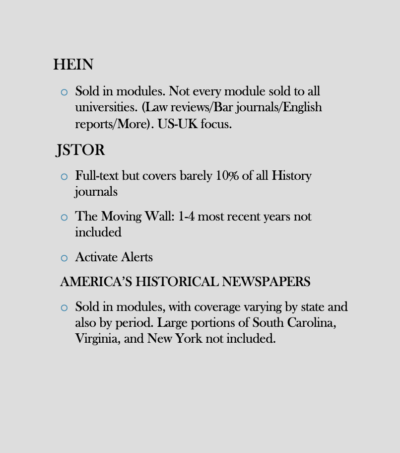
Other limitations: JSTOR uses something called a Moving Wall: the most recent issues of some journals may or may not be included, up to several years’ worth.[v] Students think that JSTOR’s full-text capability means full text of everything—but when JSTOR was built, publishers feared it would mean the death of their journals, so they cut deals with JSTOR to not provide anywhere from 1 to 5 years of most recent coverage. The newest stuff will not always be on JSTOR, unless a library pays for additional subscription coverage for the most recent year.
To describe JSTOR’s coverage, I use the analogy of an oil rig with students: it’s great for digging straight down in a very narrow hole.
Worse, JSTOR covers a relatively limited subset of history or legal history journals, roughly 10% of all the journals published in English (far less if a different language). To describe JSTOR’s coverage, I use the analogy of an oil rig with students: it’s great for digging straight down in a very narrow hole. But it is lousy for coverage of most history journals, much less the world. Students should realize that JSTOR, Hein, and many other of these electronic services, allow the scholar to set up an alert for a specific search or phrase—this is best for graduate students who have a long time frame to work on a project and who want to be alerted the moment anything new is published on a particular subject.
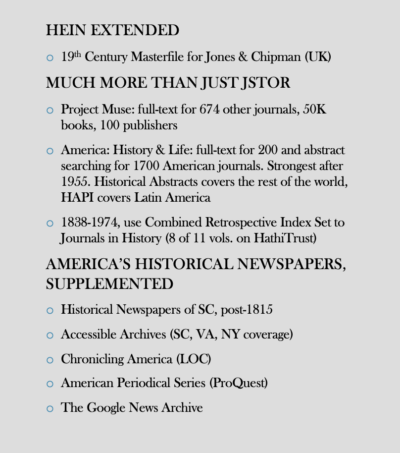
So, how to fix these particular problems? You can extend Hein’s coverage of law journals and more besides by having students search 19th-century Masterfile. It’s a database that most libraries subscribe to, since it is really useful for scholars in literature. Among other things, Masterfile includes the Jones and Chipman index, which covers legal periodical literature published in English from 1786 to the 1930s. Hein covers law journals back to their founding, but that database is focused upon currently published law journals. Jones and Chipman indexed legal literature dating back long before the twentieth century, so for projects that focus upon earlier periods, it’s a great way for students to locate earlier material.
I tell students, if you’ve only looked at JSTOR, you’ve scratched only the surface: you’ve got at least two more databases to go for current journal literature, and possibly a third. Project Muse started as a competitor to JSTOR, but isn’t as widely known and that’s a shame, because it covers a lot of territory and now has nearly as many full-text books as JSTOR has. America: History and Life was what preceded JSTOR as the major search method for locating journal literature before the early 90s, in print. Where JSTOR or Project Muse are like oil rigs, narrow but complete, America: History and Life is like top-soil: it may not be full-text, but it covers everything published in history journals about America. Its owners (EBSCO) are moving to make it completely full-text like JSTOR (they’ve gotten about 10% of the job complete) and when they complete the process, they will resume being top dog for history journal searching because their coverage is 100%, not 10%.
If you need journals for other parts of the world, there’s Historical Abstracts, or the HAPI database that UCLA for Latin American periodicals. None of these are very good before the 1970s, with some exceptions: if a student is working on a topic that requires journal articles before that time, students have to learn how to use CRIS; your library will have the volumes, but so does HATHI Trust online. CRIS is the Combined Retrospective Index Set to Journals in History, indexing history periodicals from 1838 to 1974. Particularly for projects that have an historiographical approach, students may need to work through CRIS, America: History and Life, and JSTOR, at a minimum.
To fill in gaps that America’s Historical Newspapers has, there are multiple options. Pray that the answer can be found via the American Periodical Series, as that has the best search engine of these five. Remember to tell students that the older the newspaper and search engine, the more likely the OCR made errors in “reading” the text, turning some figures (the German ß) into the letter “B” for example, or turning the “s” into an “f” (when eighteenth-century typesetters used the “f” to stand for a single “s”—the simple word “postscript” might be rendered by OCR into “poftfcript”. Wildcard searches are recommended when working with any newspaper database, to solve this kind of problem with OCR or typesetting from earlier time periods.
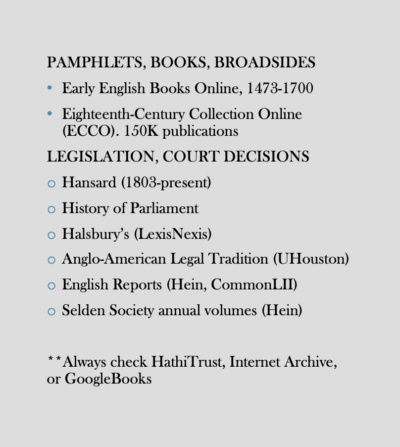
You’ve got a student who wants to look at a legal history topic that has some colonial American angle, possibly an English angle too: how ideas about the presidency seemed threatening, given what people thought about monarchy, or how English colonists thought about power? Sovereignty? Branches of government? You’ll need to be able to lead them to the English resources that will give them background for comparisons, particularly when it comes to writing about the Founding era. The fastest way to find books or pamphlets from the 15th century up to 1700 is Early English Books Online. 18th century? You want ECCO, a database built originally by the British Library using their own holdings, supplemented by Oxford’s and Cambridge’s. There’s a new database they’re building called NECCO that focuses on nineteenth-century materials that will cover the same English holdings once it is complete. To get at legislative debates in Parliament, they’ll need Hansard’s (free, fully searchable); to understand who was who, in either the House of Commons or House of Lords, they’ll need the History of Parliament biographical search; to find English statute law, they’ll want Halsbury’s. For analysis of judges, judicial biographies, court notebooks, and all sorts of legal texts—typically with fantastically high levels of documentation and annotation, then the Selden Society volumes are where to begin. Selden is devoted to English legal history and has published transcriptions and in many cases translations from Latin to English of the original medieval legal texts.
If it’s court decisions they’re after, it depends on whether they want to see print or originals. For print versions, Hein is the answer. But for photographs of the originals, you can tell them about the great resource built by legal historian Robert Palmer: The Anglo-American Legal Tradition, which has photographs of court cases from multiple legal periods. The photographs provide an excellent way to check the work completed by some of the Selden Society volume editors, since you can look at the original and then see what the editor thought was going on.
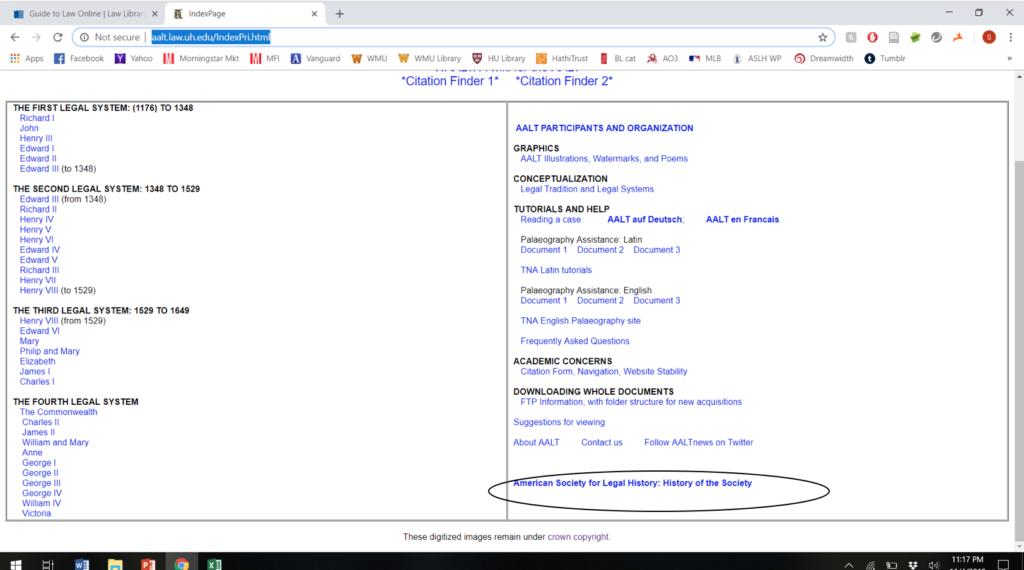
Palmer’s Anglo-American Legal Tradition has some Easter Eggs hidden inside: this is the current home of the history of our own society, the American Society for Legal History, which includes oral histories conducted with many of the founding members of the society, as well as many documents related to the society’s history.

It’s tough to know exactly what your student might want or need from the other side of the Atlantic, but two great places to send them to are the Law and Legal History research guides compiled by the librarians at Bodleian Library, Oxford. They really are first-rate. A few other key databases that you might share with your students include the massive and still growing Proceedings of the Old Bailey online. This archive has searchable transcriptions of every criminal prosecution in the central London court from 1674 to 1913—a student can construct a wonderful analysis of crimes committed by gender, verdicts for innocence and guilt, and, depending on the crime, the punishments meted out–but also a lot more than that. The Old Bailey Online continues to expand by providing what the makers call the Digital Panopticon, which provides expanded records on some 90,000 criminals by pulling in related material from 50 other databases, including the census, local housing records, and even the ships used to transport felons out of the country. This extends the reach of the Old Bailey backwards in time and forwards in time, to see where the criminals came from, and then what happened to them, going as far forward as 1925. The Old Bailey has three or four other projects connected to it, including one that is reconstructing the soundscapes of the court room, as well as one that works with maps—and it is an ongoing research project, so what I tell you will probably be out of date by next week. Keep checking back for new features.
A slightly more static project is tied to the confessions and gallows speeches of convicts that were then republished for sale. This collection is hosted by law library at Harvard Law School, which hosts another collection of digitized images based upon the appeals from the American colonies to the English Privy Council. This collection is currently expanding as the creators gather additional images from the Caribbean, so as to widen it to include English colonies of the Western Hemisphere. Both of these collections owe their inspiration to the Ames Foundation, which has underwritten legal history digitization projects for several years and continues to do so. There’s an Ames Foundation website hosted by the Harvard Law School library which is growing and, while somewhat idiosyncratic in terms of what’s there, includes a wide array of high-quality digitized images of materials drawn from the special collections at Harvard and elsewhere.
Two of the biggest British databases that you ought to know about are BAILII and British History Online. While you may come across references to a database called JUSTIS which has online versions of English reports, like Hein Online does, the BAILII archive has English reports—but for free, as well as Irish court records, suits that advanced to the House of Lords, the Privy Council, and too many other areas of coverage to even list. The biggest restriction is that the bulk of its cases are those after 1990, but older material continues to be added: for example, its run of Scottish Court of Sessions material is complete, back to the Middle Ages.[vi] The database British History Online is a massive archive of data, including journals, census data, maps, images, primary sources, county-level records, basically, all sorts of good things…it is a basic beginning point for all research on British history. It was built and continues to be sustained by the Institute for Historical Research, which is housed in London. The IHR built it with a peculiar funding model: 20% of the material is behind a premium paywall, but 80% of the material in British History Online is free. They expect the paywalled stuff to support their continuing efforts to put more material into BHO and every time I look at the free side, they’ve added something new to it.
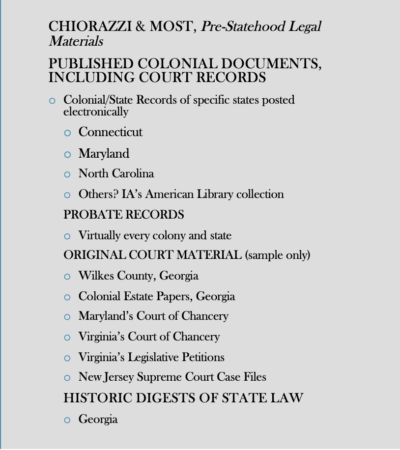
Let’s turn our attention to early America. The best source that contains all the information about legal source material is the two-volume set by Michael Chiorazzi and Marguerite Most, the Pre-Statehood Legal Materials books that describe in super detail how to locate specific types of law, whether it be appellate, original, legislative, or imperial relating to each colony or (for later state) the territorial phase of history. These two volumes continue to be the place to go when a student wants to look at territorial anything or colonial anything. Good news! Hein has recently acquired rights to use the volumes and provide hyperlinks to any resources that are currently online that are included in the volumes, so finding them online just got a lot easier.
Individual state archives have also worked to make their early historical material available. This continues a project that many states began in the nineteenth century, to assemble and then publish the entire corpus of pre-statehood documents that their editors viewed as important. These collections in print are mammoth, and in many cases, can be found online via Google Books, HathiTrust, the Digital Public Library of America, or the Internet Archive. To turn these volumes into electronically searchable resources, and eventually to link those volumes to originals, is work that some states have done more thoroughly than others. You can go to Connecticut, Maryland (and here), and North Carolina for great examples of states making those 19th-century print volumes available online, and others are coming online every day. A good place to look for them in a sort of clearinghouse is in the Internet Archive’s American Library collection.
Whether a state archive has digitized the resource a student needs depends very much on what they want to study in terms of law. Are they interested in studying the dead? Marriage? Property transfers? Then they are in luck—probate materials, marriage records, and land sales are typically the first items digitized, to assist do-it-yourself genealogists. The same is true of wills and any other documents tied to inheritance.
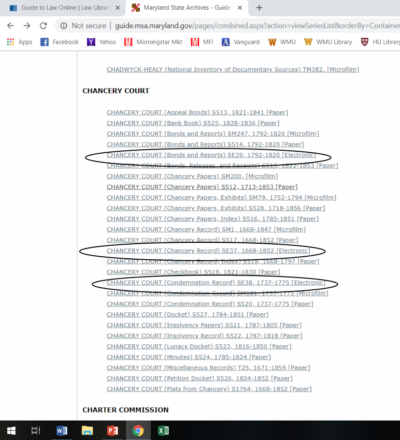
Have a student who wants to look at a more specific sort of court record? Well, then it depends on the state archive and what they have gotten around to. Georgia’s main law library has put all of its legislative digests online in one place, making it easy to track how law changed in that state. New Jersey is in the midst of a massive digitizing project that already has some 200,000 case files digitized of suits that went to its Supreme Court. More materials like this come online every day. If you look closely at the record group pages for Maryland, you’ll see that they are in what looks like the middle of a project to digitize all of their microfilm holdings—which is simply incredible! The digitized versions exist alongside the microfilm and originals, making the hard copy sources available in multiple ways. The Library and Archives of Canada in Ottawa has been undertaking the same sort of project, making it easier to work with their microfilm collections over the internet; the papers of jurists who first worked in early America and then fled to Canada as loyalists are now more widely available through this program.

In terms of materials for the Revolutionary and constitution-making era, of course you can send students to Avalon, the great repository at Yale that began by trying to collect constitutional materials and has since expanded its range dramatically to centuries before and after. The other “giant” in this area is the “Century of Lawmaking” website built by the Library of Congress. The “Century of Lawmaking” is a tremendous assemblage of primary sources related to the making of our government, from records of debates to material about relations with Native Americans and disputes about how to construct the federal judiciary. I have had many, many students construct research papers based upon taking a deep dive into the records on this site.
A growing site that some of you may know is Rotunda, the website run by the University of Virginia Press, which provides searchable access to so many collections of individuals from the Founding era, ranging from George Washington and James Madison to John Marshall and John Adams. They were able to build this by scanning and then digitizing published volumes in the various “Papers Of…” series that were underwritten by the NHPRC program over the course of many decades. UVA Press has been expanding Rotunda by adding new content that was also “born digital”, that is, primary sources that were never published in print. Among the “born digital” resources in Rotunda are selected papers from the Pinckney family in South Carolina. Of course, the biggest advantage to Rotunda is that you can search across multiple resources at the same time—and the biggest shortcoming is that Rotunda is behind a paywall.
But there are work-arounds to this. The National Archives requested and got their own copy of the digitized paper files that comprise a lot of Rotunda, based upon the US government holding so many of the originals and providing the funding that initially underwrote so many of those “Papers of…” publication projects via the NHPRC. They posted their copy of the digitized copies at “Founders Online.” So for those of you who have been unable to access material at Rotunda, the good news is that you can send your students to “Founders Online” and they can find a lot of the same materials there. It’s possible to find some of the Rotunda resources elsewhere, and sometimes with even bonus additions: Columbia has the originals of the John Jay collection, and they have digitized the originals, so you can search the transcriptions and see the originals on the Columbia website.
The Massachusetts Historical Society has been home to the Adams Papers project for fifty years or more, and they likewise have posted not just the volumes of John Adams papers that they published, but ALL of the Adams family papers volumes, several hundred of them, and they are rapidly scanning the originals to upload. The bonus here is that, for the published paper volumes, they had to pick and choose which documents were included…but with digitization, the MHS can go back to scan and transcribe everything that they have about all of the Adamses. In the end, the Mass Historical Society website will be better than Rotunda, since it will have all of the Adams corpus for several generations, without the selectivity that went into the printed volumes. This will give students the opportunity to look at legal practice across multiple generations of a single family, as well as their thinking and writing about the legislative process, the interaction of the three branches, and many important exchanges on international law and diplomacy.
Projects undertaken by repositories and archives are transforming the landscape of research for scholars of our generation.
Meanwhile, the volumes related to the Ratification process aren’t just at Rotunda—they are also available at the University of Wisconsin, which provided a home for the ratification papers project for several decades. For those who want to scout farther afield to resources that aren’t in Rotunda, there are collections like those created by the folks at Duquesne, which contains the various versions of the Pennsylvania constitution and other documents as well. At the Colonial Society of Massachusetts, they have uploaded all of their volumes online as well, which provides access to the working papers of several lawyers from the founding era like Josiah Quincy, as well as important figures on the English side, like Thomas Hutchinson and Francis Bernard, both governors in Massachusetts in the 1760s and 70s. These and many other projects undertaken by repositories and archives are transforming the landscape of research for scholars of our generation.
Of course, students are interested in more than famous lawyers and lawmakers, and their attention is usually drawn to trials and slavery when it comes to looking beyond the creation of the United States. You can point them to the superlative collection of materials on the Salem Witchcraft trials hosted by the University of Virginia library (not behind a paywall) or the collection of materials on Famous Trials through history, created by Douglas Linder, emeritus from UMKC, and now hosted outside of the university’s servers. The Famous Trials collection is a terrific place where students can take a deep dive into a particular trial and review all sorts of documents that relate to it. The collection spans millennia, from the trial of Socrates all the way up to the Enron prosecutions and the Trayvon Martin suit.
On slavery, there are a wealth of options, and I’ve highlighted three but there are many more. Virtually every state archive or private repository has digitized some, if not all, of the papers that they house relating to slavery and trials. Some of that material can be found on the website hosted at University of North Carolina in their “Documenting the American South” online collection, which continues to grow. But there are three that you ought to point students to as great starting points: the Library of Congress long ago digitized its collection of materials about slavery in the courts, which was originally made available via microfilm, and then later in volumes edited by Paul Finkelman. With the advent of cheaper technology, they’ve uploaded all of that material online and your students will find amazing stuff in there.
Legislative petitions are one of the great underused resources in archival research, in part because they are scattered and typically poorly catalogued; now, at last, they are available online.
A second tremendous and (to my way of thinking) underused resource is the slavery petitions project that was spearheaded by Loren Schweninger at University of North Carolina at Greensboro. Schweninger devoted some 15 years or more of his scholarly career to getting copies of all the petitions across the South, from every state archive and repository that he could pry them out of, and these petitions are addressed to various state legislatures on practically every topic you can imagine: pardoning individuals sentenced to die for crimes, requests to remain within a state after being manumitted, community requests for slaves to be manumitted for a particular action, requests to correct wrongs or injustices committed against individuals, and much more. Legislative petitions are one of the great underused resources in archival research, in part because they are scattered and typically poorly catalogued; now, at last, they are available online. The online collection is far larger than the two volumes that Schweninger published that were a highly selective grouping of petitions that he thought were the most noteworthy.
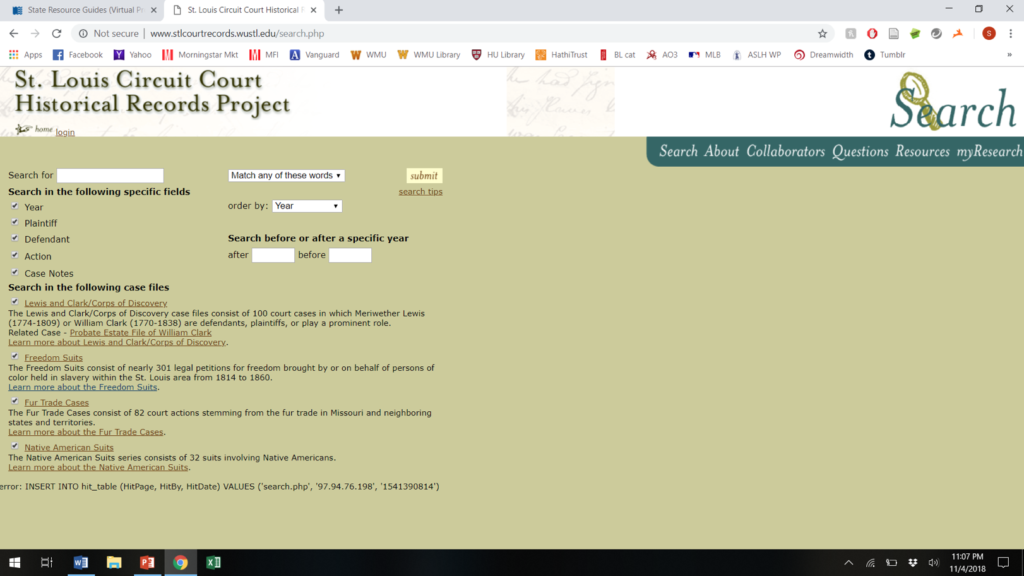
And for the past few years, we’ve been hearing a bit more about the St. Louis Freedom Suits papers, via the publications of several of our members. I’m bringing up this database because I want you to see that it is about slavery but also about other subjects as well, like lawsuits that relate to Lewis and Clark, the fur trade, and also Native Americans. These additional resources ought to be on your radar when a student comes looking for a paper topic related to the early national period.
Which brings me to the biggest and newest resource that will surely have Westlaw and LexisNexis CEOs screaming in their boardrooms—the newly unveiled Case Law Access Project.
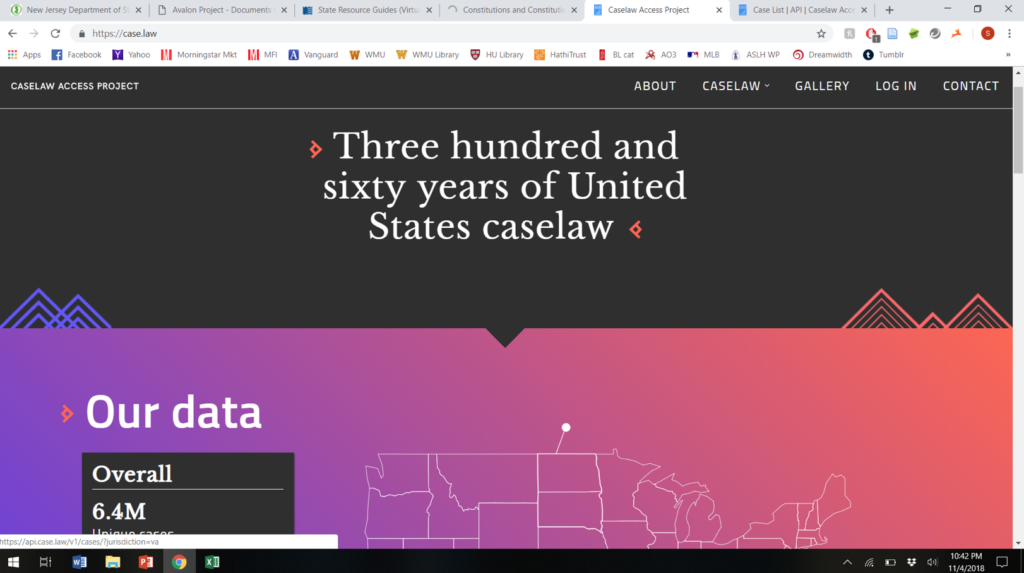
Harvard Law Library’s librarians decided to take their collection of reporters and make the materials searchable and available to the public, for free. (This is analogous to the BAILII database for Great Britain.) They teamed up with a company called Ravel (which was purchased by Lexis-Nexis after this deal went live) to scan the reporters and to make the material in those reporters, stretching back to 1658 in the colonial period, available to everybody. The works published since 1922 do not have their West apparatus, so keys and editorial notes are missing, but otherwise it is all there. From now until 2024, search results are limited to 500 case searches, but after that, the sky is the limit. Remember, OCR is still a work in progress, so wildcard searching may work better for some subjects, but the kind of research your students will be able to complete with this resource is truly mindboggling. We’ll have to see how the ready availability of mountains of data affects our students’ ability to cope with the equivalent of Mt. Everest in data, as they dig into the riches that this new resource makes available to us.
Working with large datasets is actually tailor-made for Google Books, the onetime project that Google had to scan all the books possible—the project that stopped when they ran into all sorts of lawsuits from publishers and authors. Still, the kinds of searches that Google Books make possible will allow our students to track word usage and evolving instances of new terminology within the legal realm with more ease than ever before. For those of you who aren’t familiar with N-gram searches Google Books has an Ngram Viewer that can plot the occurrence of search strings across all the books that they have scanned, and then plot those occurrences, plus it can take students to the primary source material where those occurrences were found.
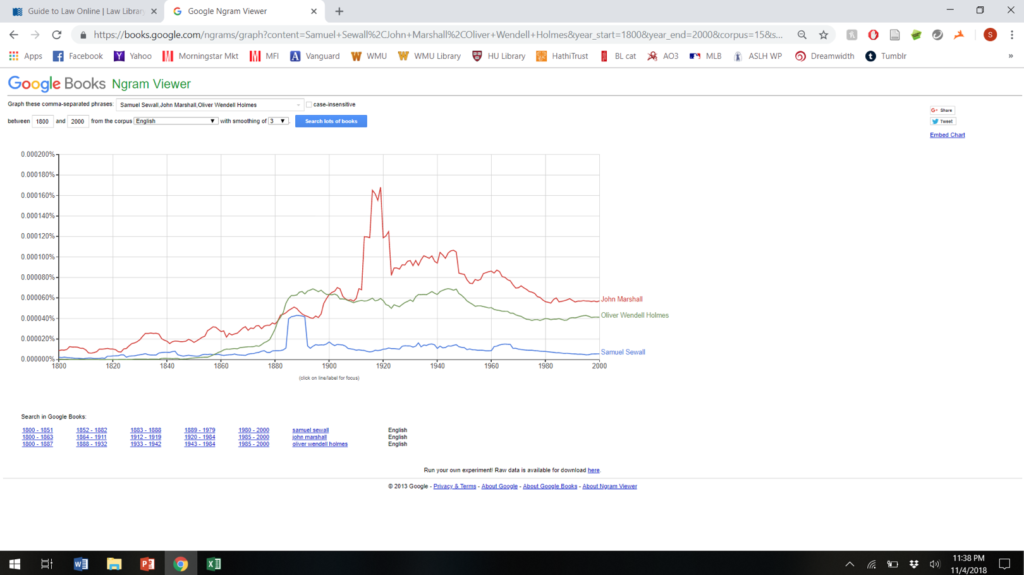
In this sample search, I plotted the frequency of three names (Samuel Sewall, John Marshall, and Oliver Wendell Holmes, three well-known judges at different points in the American past) and you can see that John Marshall really came into his own in the early 20th century…while Samuel Sewall appears to have enjoyed a resurgence in the 1880s and 90s for some reason. Students who can work with different languages can adjust the searches and Ngram results to use French, German, and other sources—and this means that some European legal history work just got a lot easier. For those of you familiar with the work of Kellen Funk and Lincoln McMullen, which you could have heard about at last year’s Preyer Scholars panel, or read more about in a recent issue of the American Historical Review, Ngram analysis on a more sophisticated platform has enabled them to track the replication of various parts of the Field Code across the United States. I suspect we are only at the beginning of what the Ngram analysis can do for us in legal terms. If, for example, there’s a way to download material from the Case Law Access Project and run it through an Ngram analysis at some point in the future, we may be in for very interesting times ahead in legal history.
I’ve undoubtedly left out several of your favorite websites in order to fit this time slot and my attempt to highlight digital resources that work well for the 1600s, 1700s, and 1800s, and I’d like to now invite you to share some of your favorites with us in the comments below, so that others may benefit from the collective wisdom we have about digital resources in legal history.
[i] The author thanks Katrina Jagodinsky of University of Nebraska for organizing the ASLH pre-conference workshop.
[ii] HeinOnline markets different modules to law schools than to undergraduate institutions in the United States, for example. See https://home.heinonline.org/heinonline-core-options/
[iii] JSTOR charges more for access to current issues, bundling items by interest groups as well as charging more for specific journals. https://www.jstor.org/librarians/fees/
[iv] See their marketing flyer that highlights this modular flexibility: https://www.readex.com/sites/default/files/productflyers/EAN-flyer.pdf
[v] https://support.jstor.org/hc/en-us/articles/115004879547-JSTOR-s-Moving-Wall-Archive-vs-Current-Definitions
[vi] Grid showing coverage here: https://www.bailii.org/bailii/summary-cases.html


 She is the author of
She is the author of